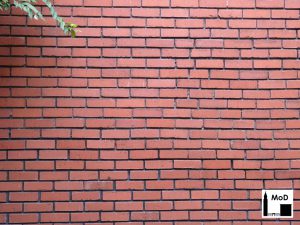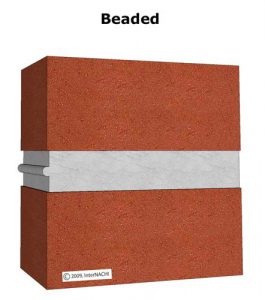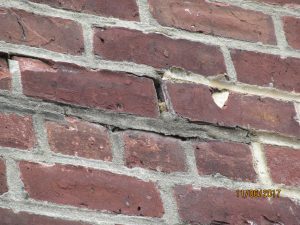The construction term pointing refers to the finishing of mortar joints in masonry whether it’s stone or brick. Since mortar often does not have as long a lifespan as the brick it holds together, it must be periodically removed and replaced. Repointing is the process of removing deteriorated mortar from the joints of a masonry wall and replacing it with new mortar. If properly performed, repointing restores the visual and physical integrity of the masonry, thereby increasing the longevity of the building envelope and any required building envelope surveys.
Mortar joints in exposed masonry are susceptible to weathering, which leads to water infiltration. Along with wind and pollution, water infiltration causes the mortar to erode, which further allows more water infiltration to occur. Mortar can also crack due to uneven settlement in a building’s foundation. As a structure settles into the ground over time, stress is transferred into the structure itself. This stress causes mortar joints to crack and peel, which also leads to more moisture entering the deteriorated mortar joints.
When the temperature falls below freezing, water in the masonry or the joints will freeze and expand. This phenomenon, commonly referred to as freeze/thaw cycles, will eventually cause the mortar and brick to spall. Cracking and deterioration can also occur if thermal expansion is not accounted for, which is more common in older buildings that were constructed without expansion joints. Contraction and expansion are very hard on mortar, particularly in areas that are subject to extreme temperature swings.
 Telltale signs of mortar deterioration include mortar erosion exceeding one-fourth of an inch, crumbling mortar, voids in the mortar, and hairline cracks in the mortar and bricks. These signs should not be ignored. To ensure there’s no further damage to the building, repointing should be performed as soon as possible.
Telltale signs of mortar deterioration include mortar erosion exceeding one-fourth of an inch, crumbling mortar, voids in the mortar, and hairline cracks in the mortar and bricks. These signs should not be ignored. To ensure there’s no further damage to the building, repointing should be performed as soon as possible.
The process of repointing starts with surface preparation. The existing masonry joints are cut out to a uniform depth of approximately three-fourths of an inch or until sound mortar is reached. The joints and surface are cleaned of debris and thoroughly wet. Once the surface is prepared, new mortar is carefully placed in the joints using a small trowel. The fresh mortar should be pressed firmly into the joints to form a strong bond with the existing interior mortar. The mortar joints should then be tooled to match the desired profile.
There are several different types of pointing profiles that can be achieved.  Flush pointing is when mortar is pressed hard into the raked joints and finished off flush with the edge of masonry units. The edges are then neatly trimmed with a trowel and straight edge. The flush joint helps bridge any height differences between adjacent bricks or stones and prevents water and dirt from collecting in any low spots. A modification of flush pointing is weathered pointing. The face of the pointing is kept inclined, with its upper edge pressed inside the face by about 10 millimeters. Weathered pointing throws off rainwater and is considered fairly durable; however, it can be quite difficult to achieve.
Flush pointing is when mortar is pressed hard into the raked joints and finished off flush with the edge of masonry units. The edges are then neatly trimmed with a trowel and straight edge. The flush joint helps bridge any height differences between adjacent bricks or stones and prevents water and dirt from collecting in any low spots. A modification of flush pointing is weathered pointing. The face of the pointing is kept inclined, with its upper edge pressed inside the face by about 10 millimeters. Weathered pointing throws off rainwater and is considered fairly durable; however, it can be quite difficult to achieve.
Concave pointing is formed by making the mortar flush with the face brick and then striking it with a brick jointer. The jointer keeps the mortar flush with the bed on the masonry units while slightly concaving the middle of the joint. Since concave pointing is easy to achieve and offers a high level of weather protection, this joint is commonly used.
 Beaded pointing is used almost exclusively in historical restorations. This joint looks like a raised bead on top of a flush joint. Beaded joints can be much more noticeable, making the mortar joints part of the structure’s visual aesthetic.
Beaded pointing is used almost exclusively in historical restorations. This joint looks like a raised bead on top of a flush joint. Beaded joints can be much more noticeable, making the mortar joints part of the structure’s visual aesthetic.
Recessed pointing, sometimes referred to as raked joints, is when the mortar joint is raked back a certain depth from the face of the brick. The mortar is first made flush with the brick and then raked out to the desired depth. Recessed mortar joints were mainly an aesthetic choice to draw attention to the brick rather than the mortar. This type of pointing provides lower resistance to weathering since the bed of the masonry below the joint is exposed. Water can sit on this bed joint and slowly be absorbed into the wall.
 While mortar repointing is necessary, it is not the only solution to building envelope deficiencies. Water entry can result from deficiencies in flashing, waterproofing, gutters, lintels, sills, sealant joints, and more. It’s important to determine the root causes of any observed deterioration, and the sources of water infiltration, before performing any repair work. Without eliminating the source of the problem, mortar deterioration will continue, and repointing efforts will be a waste of time and money.
While mortar repointing is necessary, it is not the only solution to building envelope deficiencies. Water entry can result from deficiencies in flashing, waterproofing, gutters, lintels, sills, sealant joints, and more. It’s important to determine the root causes of any observed deterioration, and the sources of water infiltration, before performing any repair work. Without eliminating the source of the problem, mortar deterioration will continue, and repointing efforts will be a waste of time and money.
In most cases, the project costs associated with the external restoration of a building are relatively low in comparison to the benefits, which often include an increase in property value and subsequent resale factor. Additionally, the reduction in risk and potential for more costly structural defects in the future can often outweigh the immediate costs of repointing.
